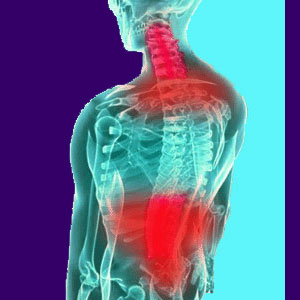
Scoliosis pain is not a usual symptom actually caused by the presence of a mild to moderate side-to-side spinal curvature. Most diagnosed patients do not experience any pain from their scoliosis conditions. Many of the patients who do develop pain are actually suffering from mindbody symptoms often brought on by the diagnostic nocebo effect of the curvature, rather than the curvature itself. Of course, this is not to say that all cases of scoliosis are asymptomatic. Although research data show that most minor cases are nothing to worry about, serious spinal curvatures are another matter altogether. Severe and extreme scoliotic curvatures can cause terrible pain and a variety of disabling neurological effects through various processes.
The scope of this article will examine the obvious and lesser considered reasons why a patient may experience pain in association with a scoliosis condition.
Physically-Motivated Scoliosis Pain
Scoliosis is a relatively common condition and the majority of patients have very mild curves that do not require any treatment whatsoever. Most minor spinal curves will not cause any pain or even be noticeable to the patient or others.
Moderate to severe scoliosis may be symptomatic, but always needs to be monitored. Some severe cases of scoliosis actually do compromise the integrity of the spine and can cause painful expressions in the spinal structures, back muscles or internal organs. These symptoms can be generated due to nerve compression, organ compression and a plethora of other case-specific reasons.
True structurally-induced pain from advanced scoliosis should be treated medically and possibly surgically. It is unfortunate that medical science does not have many options when it comes to scoliosis correction. Hopefully in the future, doctors will have a better idea of the genetic causation of scoliosis and will be able to prevent it, rather than treat it.
Mindbody Spinal Curvature Pain
Out of the minority of scoliosis patients who do have pain, some are actually suffering from a psychosomatic reaction to the nocebo effect of the diagnosis. In plain language, this means that the patient has been frightened by being diagnosed with scoliosis and the mind takes the opportunity to create painful symptoms based on expectation, rather than biological causation. Although the symptoms will seem completely structurally-motivated, they are actually enacted by the mind.
This type of scoliosis pain can not typically be treated successfully using drugs or surgery. The only proven treatment for a psychosomatic reaction of this kind is knowledge therapy. This is the only treatment that treats the actual psychoemotional cause of the symptoms, rather than wasting time treating a scapegoat physical abnormality.
It is crucial to remember that patients may have mindbody contributions to pain instead of just an exclusive cause. This means that even if a significant scoliosis condition exists and generates some symptoms, the pain may be intensified or extended in duration due to psychological overlay. All chronic pain conditions have an emotional component and it is crucial to keep this in mind if the condition becomes particularly resistant to traditional care practices.
Scoliosis Pain Facts
It is crucial that doctors inform and reassure a patient about the truth of their scoliosis conditions. Diagnosed patients should understand that mild to moderate spinal curvatures are rarely painful and should not cause them any disability. This is especially important in young patients who are prone to experiencing terrible fear, insecurity and exclusion due to their spinal curves. Parental and peer support can make the difference between a life filled with satisfaction and a life dominated by pain.
When I was diagnosed with scoliosis at age 16, I thought my life was over. My chiropractor did nothing to reassure me that my condition was stable and not worthy of fear. Instead, I was made to feel as if I was damaged and in need of lifelong treatment in order to maintain health and function. It is no wonder why I developed such a disposition towards psychological back pain after this diagnosis. Looking back, my many years of suffering might have been prevented if this doctor had simply told me the truth, rather than trying to secure a new patient for his practice.
Later on, I learned that my curve was so slight that it actually fell into normal parameters and did not even quality as scoliosis at all. Too bad it took several years for this to occur. By this time, I was already deeply entrenched in the battle for my very life against a host of misdiagnosed back pain conditions. Although I can’t change my past, I can at least create the chance to prevent this same injustice from occurring to another innocent person.





